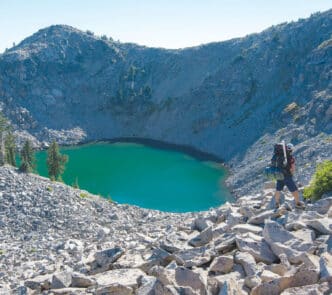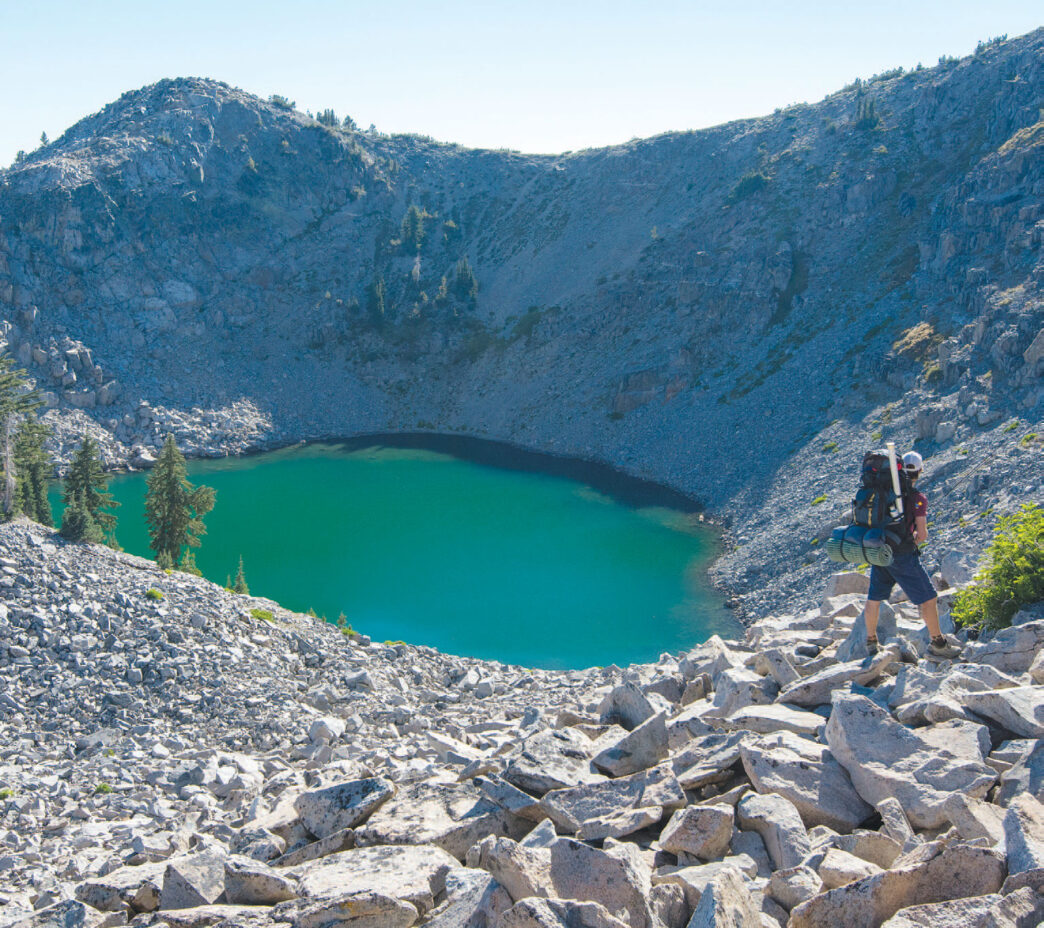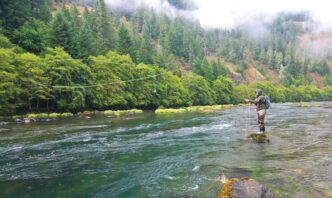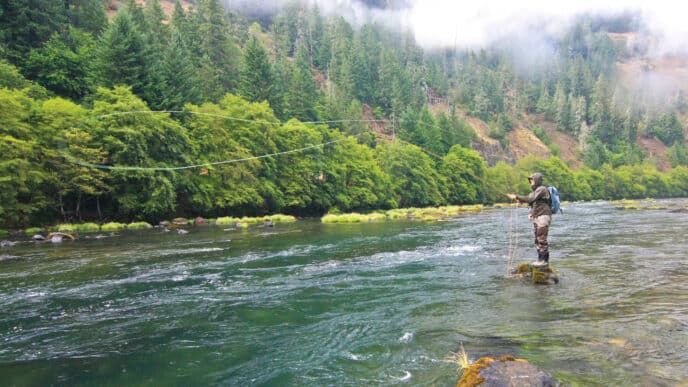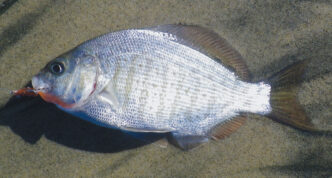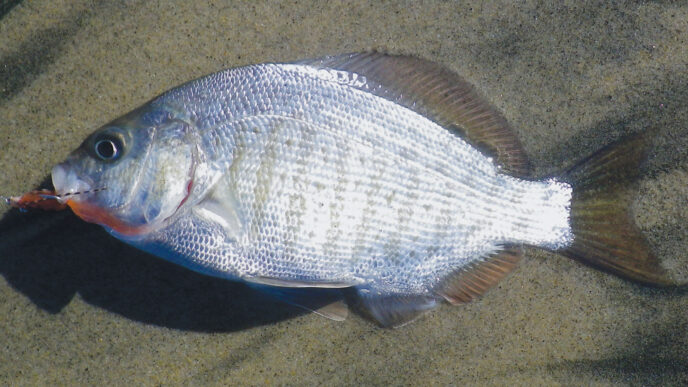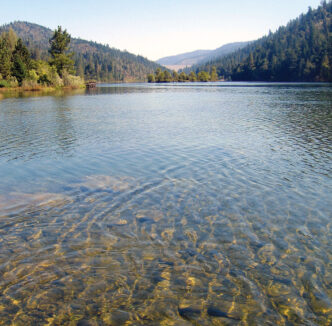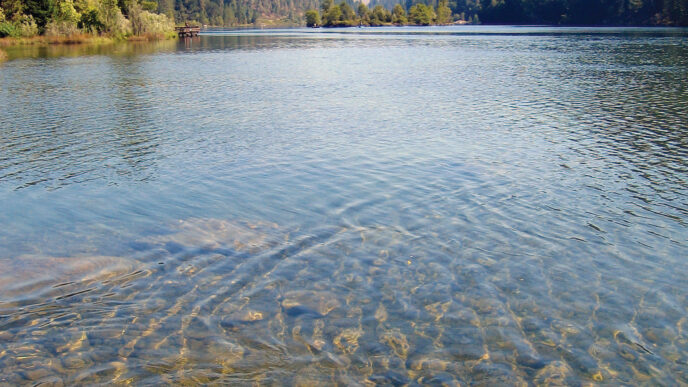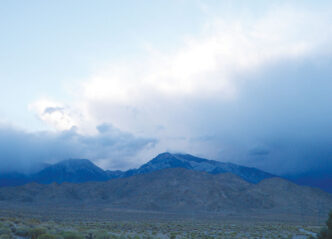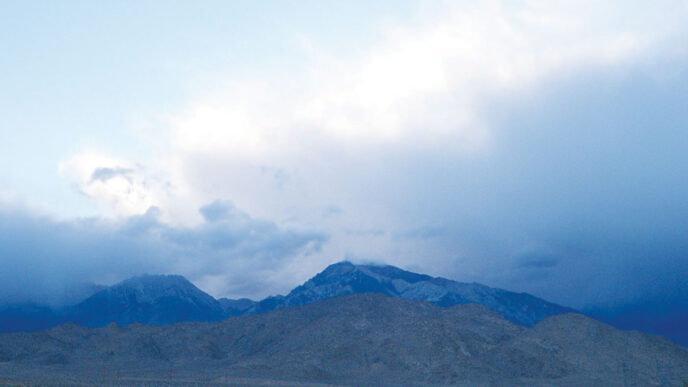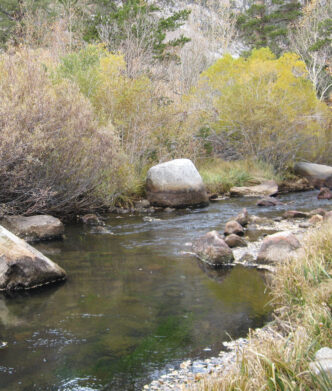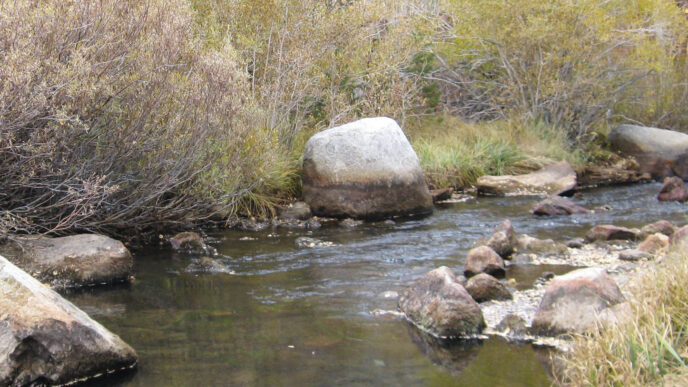Some experiences are made rewarding more by the challenge of achieving them than by anything else. This is certainly true in the case of fishing Cup and Saucer Lakes. Sure, there are plenty of Sierra lakes where an angler can drive right up and catch trout larger than those found in Cup and Saucer, but the excitement of fishing Cup and Saucer Lakes doesn’t involve the size of the quarry. The solitude, beauty, and voraciousness of the plentiful trout there are the motivating factors in attempting the trip to these high-country lakes, attributes that are closely tied to the difficulty in reaching them.
Though not actually very far from Highway 50, these lakes are essentially as hard to reach as very remote backcountry destinations because of the elevation that must be climbed to reach them and the lack of a trail to aid in making the brutal ascent. Saucer Lake is tucked on the far side of a steep ridge that looms above Highway 50 opposite the Sierra at Tahoe Ski Resort, near South Lake Tahoe. Cup Lake is to the west, at the bottom of a deep bowl on the other side of the ridgeline. The best way to access them is to park along Highway 50 near the ski resort, then start trekking through the forest at the base of a daunting climb.
The hike up to the ridgeline is steep, long, and brushy. The first half of it is the easiest going as you pick your way through the forest, assuming you start across from the ski resort in order to take the most direct route. There are rocky areas to navigate, but the main struggle is just how steep the grade is. The ground is mostly duff, though, so enjoy the clear hiking while you can. It quickly becomes steep enough to necessitate climbing switchback style. You will really appreciate packing light to minimize fatigue.
Eventually, the forest gives way to thick brush that stands about chest high. This is the most trying section of the climb, because the grade is no less steep, but each step is a challenge as you crash through the shrubbery. A heavy pack makes this effort all the more frustrating.
If you can earn your way through a few hundred yards of thick bushes, the worst of it will finally be over. After the last push through this mess, the shrubbery turns to vegetation that can be picked through with less effort.
Of course, when attempting a climb without trails, no two times up the mountain will result in the same path. Therefore, the exact route that you take will dictate just how rough the overall experience will be. There is certainly no easy way to get to Cup and Saucer Lakes, but some routes may be a lot more difficult than others.
One very helpful way to minimize the difficulty of the trip is to bring your smartphone. Although disdain is often the knee-jerk reaction by many anglers at the idea of carrying a cell phone in the wilderness, my iPhone proved invaluable on this trek. Each time I found myself in thick forest or surrounded by tall brush, I brought up a satellite to figure out my exact location and in which direction to proceed for the path of least resistance. Technology can be a bane, but in this case, it was most definitely a boon.
The home stretch entails working around rock outcroppings and bushy sections to get to the top of the ridge. Up there, the large boulders multiply in number, and a fair bit of rock hopping and climbing become necessary to make it over the crest.
Upon completing my ascent, I was greeted with a view right down into the sweetest sight I could have imagined: the cool, blue waters of Saucer Lake. The entire hike from the highway to the lake’s shore took a little under three hours, but keep in mind that youthful exuberance was on my side. It felt a whole lot longer, because time has a way of slowing down when bushwhacking through chest-high brush on a nearly vertical slope under the summer sun.
Reaching the lake was cause for elation, and the exhausting climb had made my thoughts of fishing turn to swimming. This quickly changed, though, because I could see no fewer than half a dozen trout cruising the surface and intermittently rising before I had even made it down to the water.
I’d planned this backpacking excursion because of rumors of golden trout. The steep climb certainly felt reminiscent of past expeditions that ended with golden gratification. With these thoughts on my mind, I assumed that the cruisers were goldens. It took me just minutes to get my pack off, string up a rod, pick out a fly, and have an ant pattern twitching in front of the nearest fish. The ant lay unperturbed on the surface for all of a few seconds before it was bull-rushed and taken down with a gulp. This scenario repeated itself on the following four casts. There was no shortage of fish to which to sight cast in this tiny lake, but none of them were golden trout. They were brookies — gorgeous and aggressive — and the fishing was an absolute blast.
Because this is a high-elevation lake with scant aquatic life, the fish rely on terrestrial insects for the majority of their diet. Thus, despite its impressive depth, the trout cruise the edges of the lake in search of such fare as ants, beetles, and grasshoppers. This makes for an ideal sight-casting scenario, because there is little point in casting without a target. The beauty of a tiny lake with so many fish is that rarely does more than a minute pass before another willing player is swimming in your direction. My technique of choice was to cast a buoyant ant or beetle fly a few feet ahead of the nearest fish and then twitch it to attract attention. This would induce an aggressive strike almost every time. To put into perspective just how many brookies are packed into this little lake, I stopped catching them because I wanted to take a break to snap photos and swim, not because there weren’t more willing cruisers in the vicinity.
Although I usually practice catch-and-release angling, I make an exception at lakes like this. Because of Saucer’s small size and limited supply of food, the brookies here are stunted as a result of overpopulation. These trout have exceeded the carrying capacity of their environment, so fewer fish would actually benefit the population and let some grow a bit larger. Currently, these brookies range only from about 6 to 10 inches in size. Without guilt, I killed three specimens and enjoyed them pan-fried in olive oil. There are few pleasures as tasty as fresh trout in the high country. As for the goldens, the most likely scenario is that a recent harsh winter resulted in a fish kill, and they have yet to be reintroduced.
Making it to Saucer is an impressive feat, but reaching Cup Lake from Saucer is another challenge altogether. The only way to get from one lake to the other is along the crest of the ridgeline. This may conjure up images of a serene walking experience, but the reality is a very slow couple of miles of boulder hopping and finding ways around massive chunks of granite. This will force you back down into nasty brush in many places, the only way to avoid climbing vertical rock faces.
Once you have navigated the trying ridgeline, the real excitement begins upon reaching an expansive scree slope. The scree is not small, but consists of decent-sized granite slabs precariously sitting on a steep slope at the angle of repose. This is where great caution must be exercised, because there is a very real element of danger involved in negotiating this rocky slope to Cup Lake.
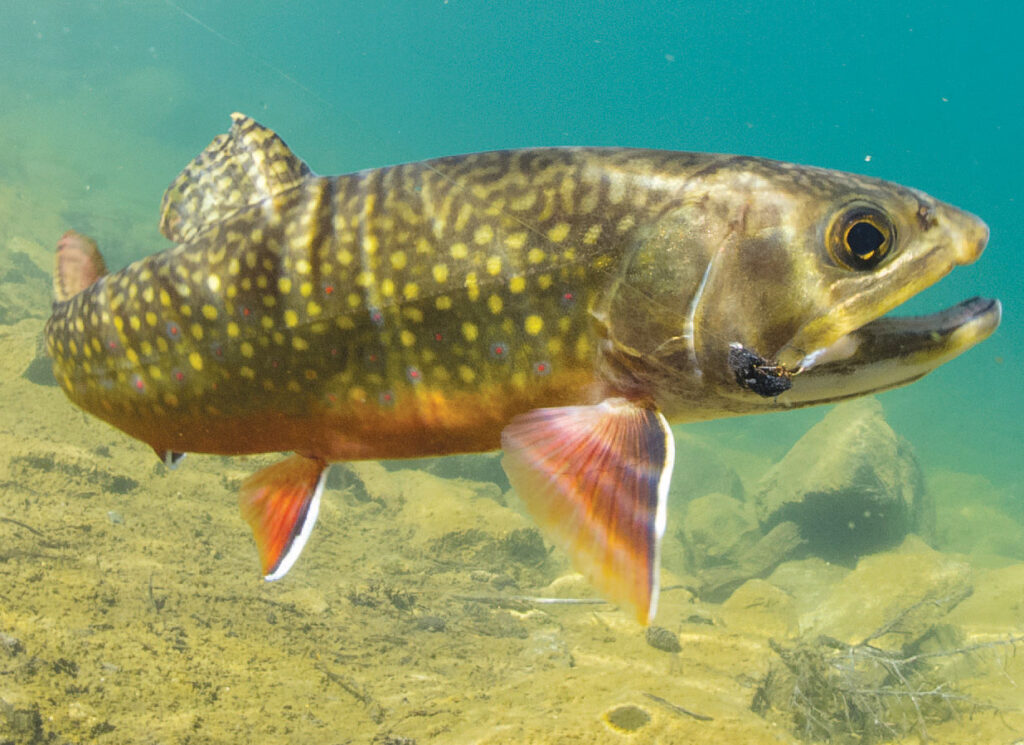
Crossing the scree slope is the only way to reach the low saddle that allows access into the bowl in which Cup lake sits. It is treacherous because many of the granite chunks are just barely balanced on the ones below, so one false step could lead to injury if a rock flipped from underneath you and crushed an ankle or knee. It is critical to test each step before placing weight on a rock, to ensure it is well-balanced and can support the weight. This makes for a tedious and nerve-wracking last stretch leading in to Cup. The scramble over the scree should not be attempted early or late in the season, when snow and ice are possible.
Once you’re finally at the saddle above the lake, the intensity of the hike melts away, and the breathtaking beauty of Cup makes it all worth it. This azure-blue lake is a sight to behold.
Though larger than tiny Saucer Lake, Cup is still relatively small. The fishing here is similar to that at Saucer in that the lack of aquatic life means the trout stay close to shore in search of bugs blown onto the water by the wind. I’d heard about goldens here, as well, but it’s as high as Saucer, and the same winter fish kill likely affected Cup. Again I found plenty of willing trout, but these were Lahontan cutthroats. They were not large, but plentiful and eager to attack a dry fly. Many of them cruised within feet of the shoreline in search of their next meal. My backpacking partner and I spent our nights camped on the eastern ridge above the lake. Though you’re high above the water, there is little in the way of choice for campsites. Besides this one prime camping spot beneath a large juniper, there are no flat spots, except a small one by the southern shore of the lake large enough for a only single person. Yes, the shores of this lake are that steep. There is literally only one place in the near vicinity to camp for a group of two or more. Saucer is even worse, where finding a spot for a multiperson tent would take some serious imagination. Because of this, I recommend sleeping at Cup and making Saucer a stop on the hike in or out, or a day trip from Cup. The Desolation Wilderness has a deceptive name, because much of it is very crowded during the summer months as a result of its proximity to Tahoe. A crowded backcountry is not my style. I enter the wilderness to find solitude, and that quest is ruined when camping at a lake with a dozen other people. Because of the strenous, difficult hike to Cup and Saucer Lakes, crowds there are nonexistent. It takes serious tenacity to reach these waters, and once there, camping is not easy. As a result, you are likely to have either lake all to yourself. Chances of seeing another angler are minimal. There is something special about casting a dry fly to aggressive high-mountain trout with nobody else in sight, knowing that you are probably the first angler these fish have encountered in weeks.
The trout at may not be big, and the scratches on your legs after the climb in may be many, but the adventure of getting to Cup and Saucer Lakes is well worth it. Whether because of the abundance of naïve trout, the stark beauty of the landscape, the wilderness solitude, or simply the gratification of making it to two of the least accessible lakes in the Sierra, the experience is sure to be memorable. This expedition is one that any fit fly angler will take pride in making.
If You Go…
Both Cup Lake and Saucer Lake are just inside the Desolation Wilderness boundary. This means that a wilderness permit must be obtained for overnight trips, and all wilderness area regulations should be followed. The easiest way to get a permit is online at www.recreation.gov. South Lake Tahoe is the best home base for a warm meal and a hot shower and is less than a half-hour by car from the starting point for the trip.
There are alternate routes into the lakes, but they are much less direct. It is possible to take a water taxi to the back of Upper Echo Lake and hike in from this side. I have also spoken with hikers who have accessed Cup and Saucer via the Rocky Canyon Trail, located near Twin Bridges. After a few miles on the trail, significant cross-country efforts must be made eastward in the direction of Ralston Peak. Ralston is pretty close to Cup, and a hike around the rim of the bowl will get you to the saddle for accessing the lake. Regardless of how you access Cup, a hike up to Ralston is recommended for the phenomenal 360-degree vistas, including a spectacular view of Lake Tahoe.
Gearing Up for High-Mountain Lakes
For high-mountain lakes such as Cup and Saucer, rods in the range from 3weights to 5-weights and from 8 to 9 feet long are best. A little 8-foot 3-weight will do just fine for throwing dry flies along the shoreline, where casts need not be more than 20 to 40 feet if you are stealthy. A rod with more backbone, preferably a 5weight, can be advantageous when the wind comes up. Breezy afternoons are the norm in the Sierra high country.
With smaller trout, a reel is little more than a line-storage tool, because the fish are played by hand, so there’s no need to get anything too fancy. There aren’t any fish in these lakes that will put you on the reel. The cheapest click-drag model at your local fly shop will be just fine for fishing Cup and Saucer.
A full floating line will do the trick the vast majority of the time. Because these mountain trout are looking for terrestrials, they tend to swim near the surface. A sink-tip line is not nearly as beneficial up around the tree line as it is at lower-elevation lakes, where trout often feed deep during the day and can’t be reached with a floater. I pack light with a single reel and floating line and fish a weighted nymph or Woolly Bugger if I want to get down a little bit.
These trout are rarely picky, so a short leader will certainly catch fish, but I prefer a 9-foot leader because of its compromise between castability and stealth. Leaders tapering to 5X are thin enough for the clear water and plenty strong for small trout. There is no need to fish 7X with fish that are so hungry. Of course, if you have a vest full of 4X or 6X leaders, they are close enough and will suffice just fine.
My go-to patterns for high-mountain lakes are terrestrials for fishing on the surface. I carry a number of foam ants and beetles, as well as smaller grasshopper patterns. It is always a good idea to bring some nymphs and small Woolly Buggers, as well, in case a stripped retrieve becomes the ticket when the wind makes the surface choppy.
Loren Elliott



